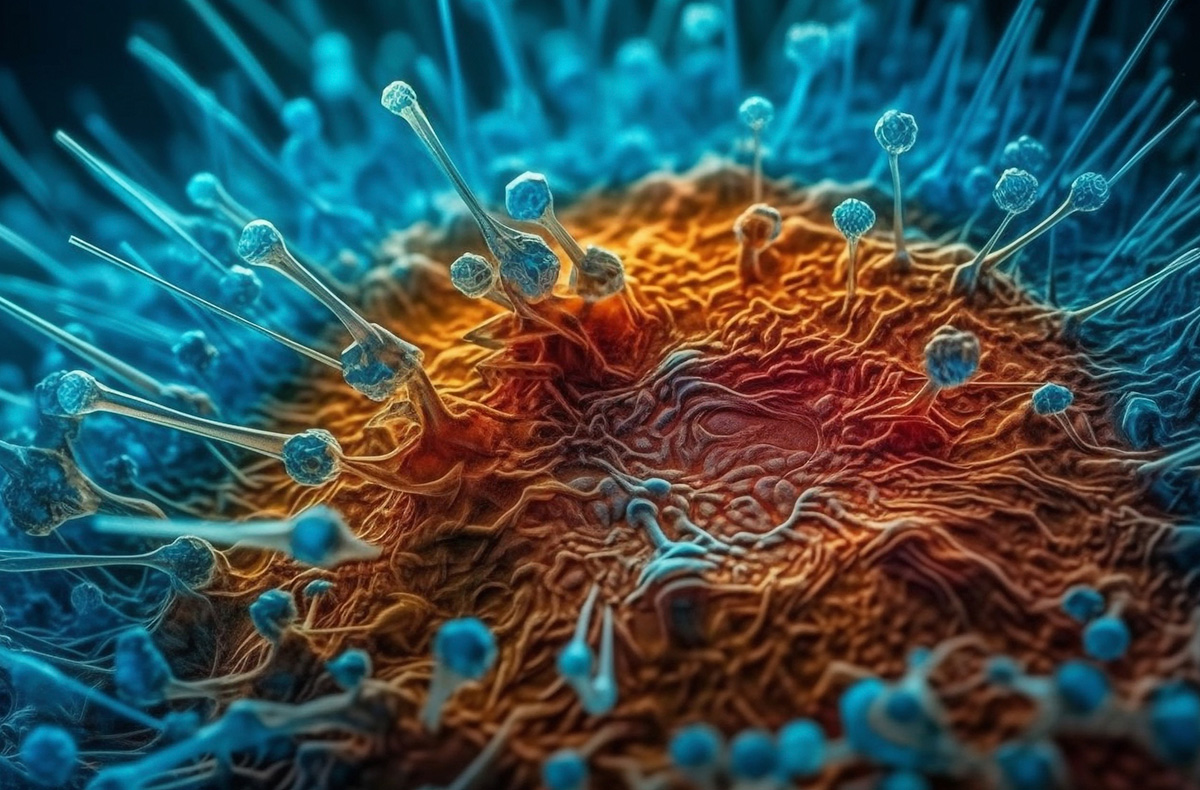The immune system is ubiquitous throughout the body. It is composed of soluble molecules, spread throughout the body fluids (blood, lymph, extracellular fluid, etc.):
- complement proteins
- the antibodies
- antimicrobial peptides
- cytokines
- amines such as histamine
- etc
Another of its components are immune cells, such as:
- neutrophils
- B and T lymphocytes
- eosinophils and basophils
- mast cells
- monocytes and macrophages
- dendritic cells
- natural killer cells
- microglial cells
These cells, in addition to being found in some lymphoid tissues and organs such as the spleen, thymus, lymph nodes, bone marrow and mucosa-associated lymphoid tissue (MALT), are also found throughout our fluids, tissues and organs, where they perform all the functions mentioned above.
I will not go into much detail about how the immune system works in the face of infection, but we can say that the immune response to micro-organism aggression is divided into an innate immune response and an adaptive immune response. The former is a response mediated by most immune cells, with the exception of lymphocytes, which destroy invading micro-organisms by different mechanisms, although in their wake they leave a significant inflammatory reaction that causes "collateral damage" to tissues. The second is a much more specific immune response that has memory. If our body has already been attacked by a micro-organism, the lymphocytes will have "taken note" of which germ it was and will have produced specific antibodies. It will take some time the first time, but on re-exposure, these antibodies will immediately recognise the offending agent and trigger a much more specific and effective response on entry.
Bibliografía:
Arponen S (2021). Es la microbiota, idiota. Alienta.
Godaly G, Ambite I, Svanborg C. Innate immunity and genetic determinants of urinary tract infection susceptibility. Curr Opin Infect Dis. 2015 Feb;28(1):88-96.
Lacerda Mariano L, Ingersoll MA. Bladder resident macrophages: Mucosal sentinels. Cell Immunol. 2018 Aug;330:136-141.
Song J, Abraham SN. TLR-mediated immune responses in the urinary tract. Curr Opin Microbiol. 2008 Feb;11(1):66-73.
Becknell B, Ching C, Spencer JD. The Responses of the Ribonuclease A Superfamily to Urinary Tract Infection. Front Immunol. 2019 Nov 29;10:2786.
Steigedal M, Marstad A, Haug M, Damås JK, Strong RK, et al. Lipocalin 2 imparts selective pressure on bacterial growth in the bladder and is elevated in women with urinary tract infection. J Immunol. 2014 Dec 15;193(12):6081-9.
Ueda N, Kondo M, Takezawa K, Kiuchi H, Sekii Y, et al. Bladder urothelium converts bacterial lipopolysaccharide information into neural signaling via an ATP-mediated pathway to enhance the micturition reflex for rapid defense. Sci Rep. 2020 Dec 3;10(1):21167.
Hayes BW, Abraham SN. Innate Immune Responses to Bladder Infection. Microbiol Spectr. 2016 Dec;4(6):10.1128/microbiolspec.UTI-0024-2016.
O’Brien VP, Hannan TJ, Schaeffer AJ, Hultgren SJ. Are you experienced? Understanding bladder innate immunity in the context of recurrent urinary tract infection. Curr Opin Infect Dis. 2015 Feb;28(1):97-105.
Huang J, Fu L, Huang J, Zhao J, Zhang X, et al. Group 3 Innate Lymphoid Cells Protect the Host from the Uropathogenic Escherichia coli Infection in the Bladder. Adv Sci (Weinh). 2022 Feb;9(6):e2103303.
Wu J, Abraham SN. The Roles of T cells in Bladder Pathologies. Trends Immunol. 2021 Mar;42(3):248-260.
Billips BK, Schaeffer AJ, Klumpp DJ. Molecular basis of uropathogenic Escherichia coli evasion of the innate immune response in the bladder. Infect Immun. 2008 Sep;76(9):3891-900.
Nielsen KL, Stegger M, Kiil K, Godfrey PA, Feldgarden M, Lilje B, Andersen PS, Frimodt-Møller N. Whole-genome comparison of urinary pathogenic Escherichia coli and faecal isolates of UTI patients and healthy controls. Int J Med Microbiol. 2017 Dec;307(8):497-507.
Ambite I, Butler D, Wan MLY, Rosenblad T, Tran TH, Chao SM, Svanborg C. Molecular determinants of disease severity in urinary tract infection. Nat Rev Urol. 2021 Aug;18(8):468-486.
Ziegler T, Jacobsohn N, Fünfstück R. Correlation between blood group phenotype and virulence properties of Escherichia coli in patients with chronic urinary tract infection. Int J Antimicrob Agents. 2004 Sep;24 Suppl 1:S70-5.
Sulaiman KA, Al Qahtani N, Al Muqrin M, Al Dossari M, Al Wabel A, et al. The correlation between non-O blood group type and recurrent catheter-associated urinary tract infections in critically ill patients: A retrospective study. J Int Med Res. 2022 Jul;50(7):3000605221108082.
Albracht CD, Hreha TN, Hunstad DA. Sex effects in pyelonephritis. Pediatr Nephrol. 2021 Mar;36(3):507-515.
Wnorowska U, Piktel E, Deptuła P, Wollny T, Król G, et al. Ceragenin CSA-13 displays high antibacterial efficiency in a mouse model of urinary tract infection. Sci Rep. 2022 Nov 10;12(1):19164.

